Critical Analysis of Research Paper: CASP Tool and Systematic Review
VerifiedAdded on 2022/12/28
|10
|3540
|42
Report
AI Summary
This report presents a critical analysis of the research paper titled "Dual Antiplatelet Therapy before Coronary Artery Bypass Grafting; a Systematic Review and Meta-Analysis" by Sadeghi et al. The analysis employs the CASP Systematic Review Checklist to evaluate the study's methodology, focusing on whether the research question was clearly defined, if the appropriate studies were included, and if the quality of the included studies was adequately assessed. The report examines the strengths and weaknesses of the study, including the methods used for data collection, the assessment of bias, and the statistical analysis of the results. The key findings, such as the impact of DAPT on mortality, cerebrovascular events, and the need for blood transfusions, are summarized. The report concludes with an assessment of the applicability of the study's results to the local population, offering insights into the clinical implications of the research and the validity of the conclusions drawn by the authors. The chosen research paper explores the effects of DAPT with aspirin and clopidogrel on patients undergoing CABG and highlights the importance of considering the balance between potential benefits and risks, such as increased bleeding complications.
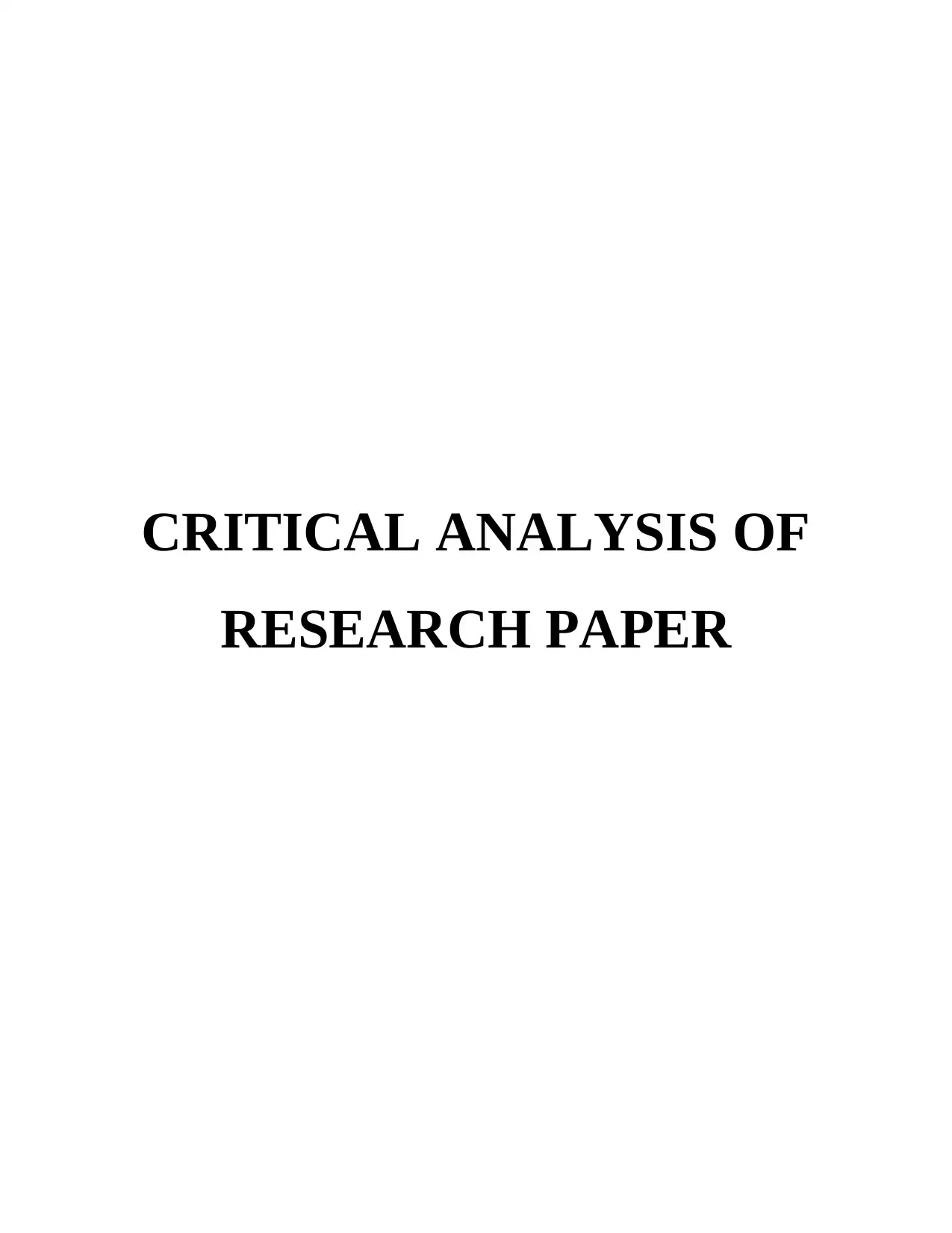
CRITICAL ANALYSIS OF
RESEARCH PAPER
RESEARCH PAPER
Paraphrase This Document
Need a fresh take? Get an instant paraphrase of this document with our AI Paraphraser
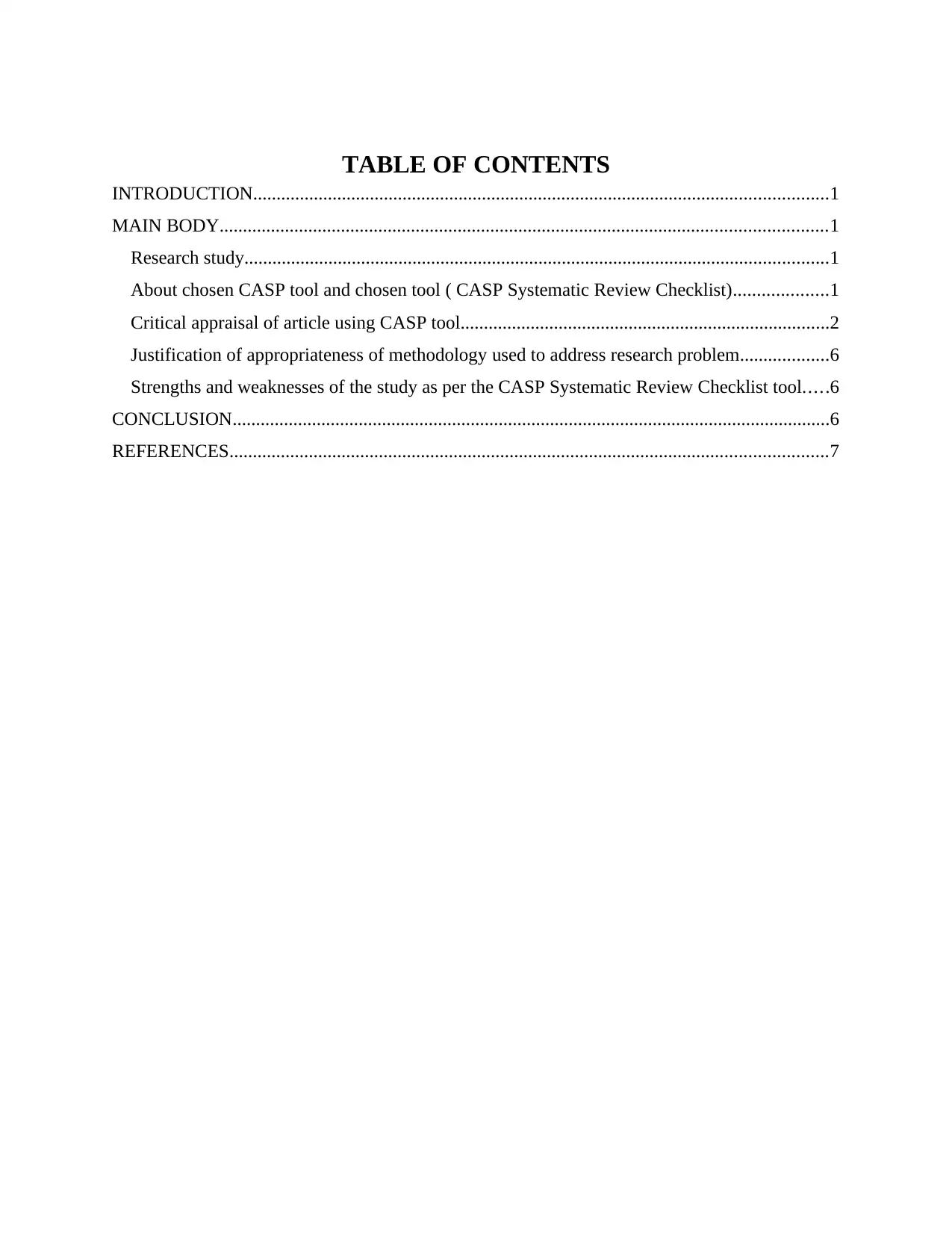
TABLE OF CONTENTS
INTRODUCTION...........................................................................................................................1
MAIN BODY..................................................................................................................................1
Research study.............................................................................................................................1
About chosen CASP tool and chosen tool ( CASP Systematic Review Checklist)....................1
Critical appraisal of article using CASP tool...............................................................................2
Justification of appropriateness of methodology used to address research problem...................6
Strengths and weaknesses of the study as per the CASP Systematic Review Checklist tool.....6
CONCLUSION................................................................................................................................6
REFERENCES................................................................................................................................7
INTRODUCTION...........................................................................................................................1
MAIN BODY..................................................................................................................................1
Research study.............................................................................................................................1
About chosen CASP tool and chosen tool ( CASP Systematic Review Checklist)....................1
Critical appraisal of article using CASP tool...............................................................................2
Justification of appropriateness of methodology used to address research problem...................6
Strengths and weaknesses of the study as per the CASP Systematic Review Checklist tool.....6
CONCLUSION................................................................................................................................6
REFERENCES................................................................................................................................7
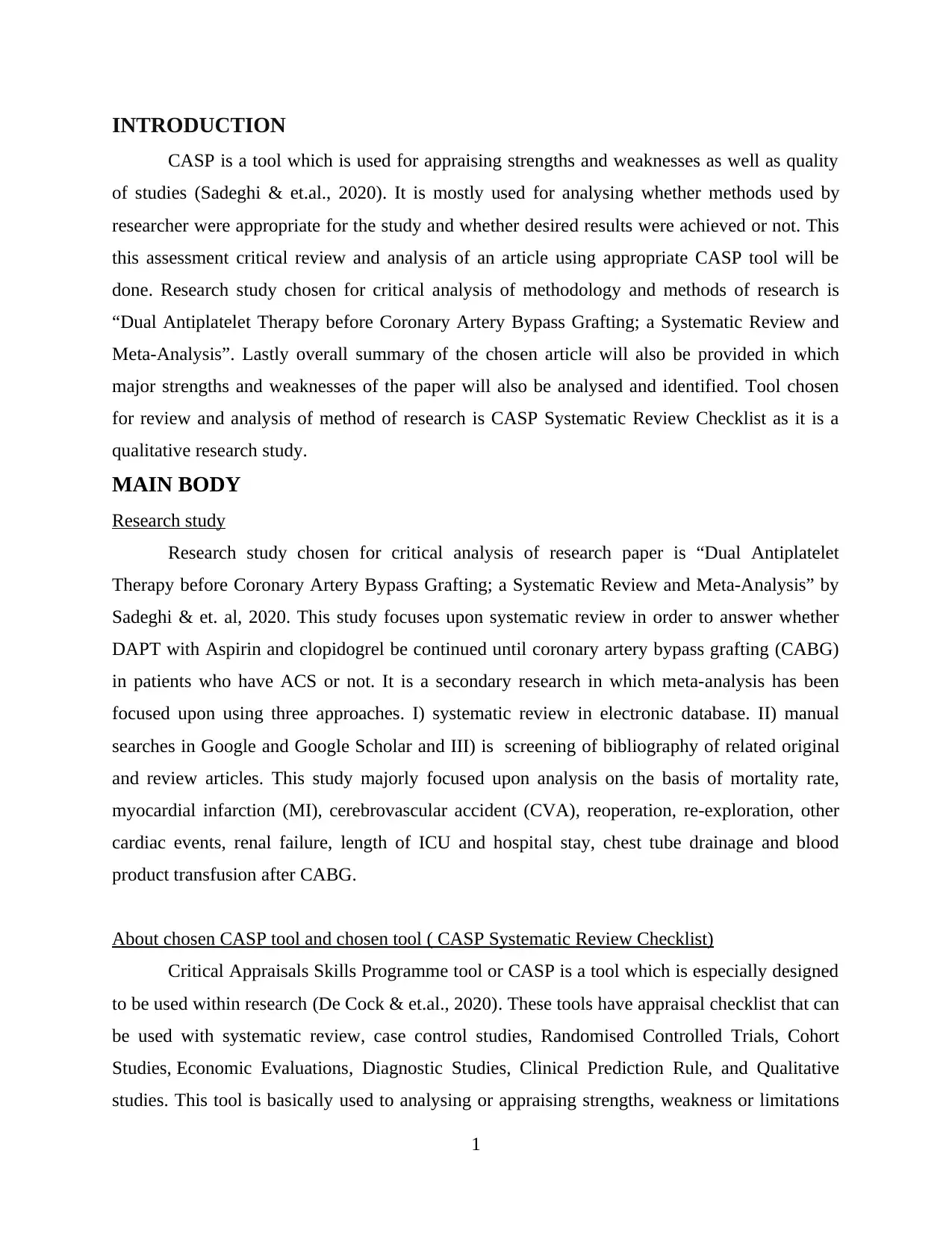
INTRODUCTION
CASP is a tool which is used for appraising strengths and weaknesses as well as quality
of studies (Sadeghi & et.al., 2020). It is mostly used for analysing whether methods used by
researcher were appropriate for the study and whether desired results were achieved or not. This
this assessment critical review and analysis of an article using appropriate CASP tool will be
done. Research study chosen for critical analysis of methodology and methods of research is
“Dual Antiplatelet Therapy before Coronary Artery Bypass Grafting; a Systematic Review and
Meta-Analysis”. Lastly overall summary of the chosen article will also be provided in which
major strengths and weaknesses of the paper will also be analysed and identified. Tool chosen
for review and analysis of method of research is CASP Systematic Review Checklist as it is a
qualitative research study.
MAIN BODY
Research study
Research study chosen for critical analysis of research paper is “Dual Antiplatelet
Therapy before Coronary Artery Bypass Grafting; a Systematic Review and Meta-Analysis” by
Sadeghi & et. al, 2020. This study focuses upon systematic review in order to answer whether
DAPT with Aspirin and clopidogrel be continued until coronary artery bypass grafting (CABG)
in patients who have ACS or not. It is a secondary research in which meta-analysis has been
focused upon using three approaches. I) systematic review in electronic database. II) manual
searches in Google and Google Scholar and III) is screening of bibliography of related original
and review articles. This study majorly focused upon analysis on the basis of mortality rate,
myocardial infarction (MI), cerebrovascular accident (CVA), reoperation, re-exploration, other
cardiac events, renal failure, length of ICU and hospital stay, chest tube drainage and blood
product transfusion after CABG.
About chosen CASP tool and chosen tool ( CASP Systematic Review Checklist)
Critical Appraisals Skills Programme tool or CASP is a tool which is especially designed
to be used within research (De Cock & et.al., 2020). These tools have appraisal checklist that can
be used with systematic review, case control studies, Randomised Controlled Trials, Cohort
Studies, Economic Evaluations, Diagnostic Studies, Clinical Prediction Rule, and Qualitative
studies. This tool is basically used to analysing or appraising strengths, weakness or limitations
1
CASP is a tool which is used for appraising strengths and weaknesses as well as quality
of studies (Sadeghi & et.al., 2020). It is mostly used for analysing whether methods used by
researcher were appropriate for the study and whether desired results were achieved or not. This
this assessment critical review and analysis of an article using appropriate CASP tool will be
done. Research study chosen for critical analysis of methodology and methods of research is
“Dual Antiplatelet Therapy before Coronary Artery Bypass Grafting; a Systematic Review and
Meta-Analysis”. Lastly overall summary of the chosen article will also be provided in which
major strengths and weaknesses of the paper will also be analysed and identified. Tool chosen
for review and analysis of method of research is CASP Systematic Review Checklist as it is a
qualitative research study.
MAIN BODY
Research study
Research study chosen for critical analysis of research paper is “Dual Antiplatelet
Therapy before Coronary Artery Bypass Grafting; a Systematic Review and Meta-Analysis” by
Sadeghi & et. al, 2020. This study focuses upon systematic review in order to answer whether
DAPT with Aspirin and clopidogrel be continued until coronary artery bypass grafting (CABG)
in patients who have ACS or not. It is a secondary research in which meta-analysis has been
focused upon using three approaches. I) systematic review in electronic database. II) manual
searches in Google and Google Scholar and III) is screening of bibliography of related original
and review articles. This study majorly focused upon analysis on the basis of mortality rate,
myocardial infarction (MI), cerebrovascular accident (CVA), reoperation, re-exploration, other
cardiac events, renal failure, length of ICU and hospital stay, chest tube drainage and blood
product transfusion after CABG.
About chosen CASP tool and chosen tool ( CASP Systematic Review Checklist)
Critical Appraisals Skills Programme tool or CASP is a tool which is especially designed
to be used within research (De Cock & et.al., 2020). These tools have appraisal checklist that can
be used with systematic review, case control studies, Randomised Controlled Trials, Cohort
Studies, Economic Evaluations, Diagnostic Studies, Clinical Prediction Rule, and Qualitative
studies. This tool is basically used to analysing or appraising strengths, weakness or limitations
1
⊘ This is a preview!⊘
Do you want full access?
Subscribe today to unlock all pages.

Trusted by 1+ million students worldwide
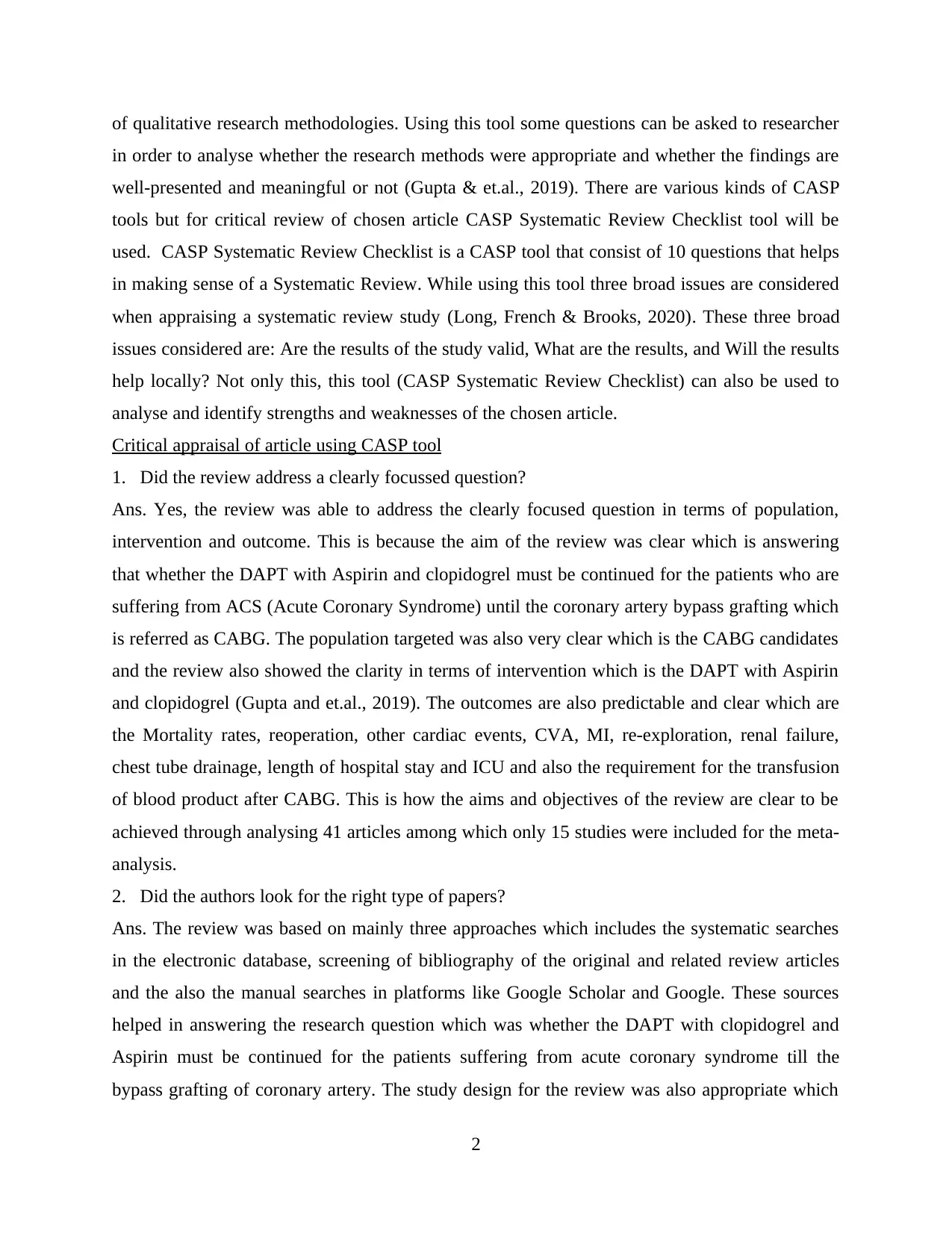
of qualitative research methodologies. Using this tool some questions can be asked to researcher
in order to analyse whether the research methods were appropriate and whether the findings are
well-presented and meaningful or not (Gupta & et.al., 2019). There are various kinds of CASP
tools but for critical review of chosen article CASP Systematic Review Checklist tool will be
used. CASP Systematic Review Checklist is a CASP tool that consist of 10 questions that helps
in making sense of a Systematic Review. While using this tool three broad issues are considered
when appraising a systematic review study (Long, French & Brooks, 2020). These three broad
issues considered are: Are the results of the study valid, What are the results, and Will the results
help locally? Not only this, this tool (CASP Systematic Review Checklist) can also be used to
analyse and identify strengths and weaknesses of the chosen article.
Critical appraisal of article using CASP tool
1. Did the review address a clearly focussed question?
Ans. Yes, the review was able to address the clearly focused question in terms of population,
intervention and outcome. This is because the aim of the review was clear which is answering
that whether the DAPT with Aspirin and clopidogrel must be continued for the patients who are
suffering from ACS (Acute Coronary Syndrome) until the coronary artery bypass grafting which
is referred as CABG. The population targeted was also very clear which is the CABG candidates
and the review also showed the clarity in terms of intervention which is the DAPT with Aspirin
and clopidogrel (Gupta and et.al., 2019). The outcomes are also predictable and clear which are
the Mortality rates, reoperation, other cardiac events, CVA, MI, re-exploration, renal failure,
chest tube drainage, length of hospital stay and ICU and also the requirement for the transfusion
of blood product after CABG. This is how the aims and objectives of the review are clear to be
achieved through analysing 41 articles among which only 15 studies were included for the meta-
analysis.
2. Did the authors look for the right type of papers?
Ans. The review was based on mainly three approaches which includes the systematic searches
in the electronic database, screening of bibliography of the original and related review articles
and the also the manual searches in platforms like Google Scholar and Google. These sources
helped in answering the research question which was whether the DAPT with clopidogrel and
Aspirin must be continued for the patients suffering from acute coronary syndrome till the
bypass grafting of coronary artery. The study design for the review was also appropriate which
2
in order to analyse whether the research methods were appropriate and whether the findings are
well-presented and meaningful or not (Gupta & et.al., 2019). There are various kinds of CASP
tools but for critical review of chosen article CASP Systematic Review Checklist tool will be
used. CASP Systematic Review Checklist is a CASP tool that consist of 10 questions that helps
in making sense of a Systematic Review. While using this tool three broad issues are considered
when appraising a systematic review study (Long, French & Brooks, 2020). These three broad
issues considered are: Are the results of the study valid, What are the results, and Will the results
help locally? Not only this, this tool (CASP Systematic Review Checklist) can also be used to
analyse and identify strengths and weaknesses of the chosen article.
Critical appraisal of article using CASP tool
1. Did the review address a clearly focussed question?
Ans. Yes, the review was able to address the clearly focused question in terms of population,
intervention and outcome. This is because the aim of the review was clear which is answering
that whether the DAPT with Aspirin and clopidogrel must be continued for the patients who are
suffering from ACS (Acute Coronary Syndrome) until the coronary artery bypass grafting which
is referred as CABG. The population targeted was also very clear which is the CABG candidates
and the review also showed the clarity in terms of intervention which is the DAPT with Aspirin
and clopidogrel (Gupta and et.al., 2019). The outcomes are also predictable and clear which are
the Mortality rates, reoperation, other cardiac events, CVA, MI, re-exploration, renal failure,
chest tube drainage, length of hospital stay and ICU and also the requirement for the transfusion
of blood product after CABG. This is how the aims and objectives of the review are clear to be
achieved through analysing 41 articles among which only 15 studies were included for the meta-
analysis.
2. Did the authors look for the right type of papers?
Ans. The review was based on mainly three approaches which includes the systematic searches
in the electronic database, screening of bibliography of the original and related review articles
and the also the manual searches in platforms like Google Scholar and Google. These sources
helped in answering the research question which was whether the DAPT with clopidogrel and
Aspirin must be continued for the patients suffering from acute coronary syndrome till the
bypass grafting of coronary artery. The study design for the review was also appropriate which
2
Paraphrase This Document
Need a fresh take? Get an instant paraphrase of this document with our AI Paraphraser
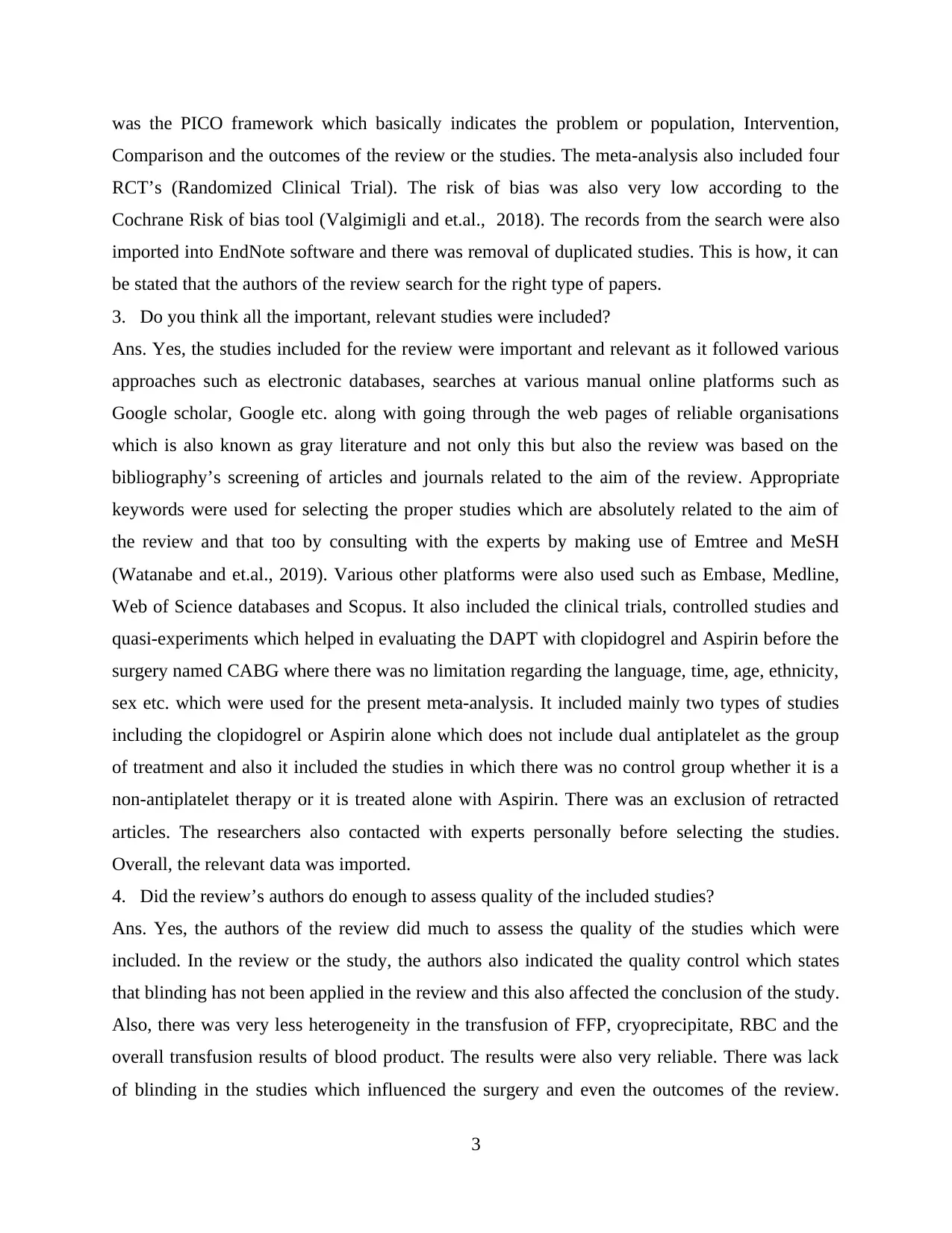
was the PICO framework which basically indicates the problem or population, Intervention,
Comparison and the outcomes of the review or the studies. The meta-analysis also included four
RCT’s (Randomized Clinical Trial). The risk of bias was also very low according to the
Cochrane Risk of bias tool (Valgimigli and et.al., 2018). The records from the search were also
imported into EndNote software and there was removal of duplicated studies. This is how, it can
be stated that the authors of the review search for the right type of papers.
3. Do you think all the important, relevant studies were included?
Ans. Yes, the studies included for the review were important and relevant as it followed various
approaches such as electronic databases, searches at various manual online platforms such as
Google scholar, Google etc. along with going through the web pages of reliable organisations
which is also known as gray literature and not only this but also the review was based on the
bibliography’s screening of articles and journals related to the aim of the review. Appropriate
keywords were used for selecting the proper studies which are absolutely related to the aim of
the review and that too by consulting with the experts by making use of Emtree and MeSH
(Watanabe and et.al., 2019). Various other platforms were also used such as Embase, Medline,
Web of Science databases and Scopus. It also included the clinical trials, controlled studies and
quasi-experiments which helped in evaluating the DAPT with clopidogrel and Aspirin before the
surgery named CABG where there was no limitation regarding the language, time, age, ethnicity,
sex etc. which were used for the present meta-analysis. It included mainly two types of studies
including the clopidogrel or Aspirin alone which does not include dual antiplatelet as the group
of treatment and also it included the studies in which there was no control group whether it is a
non-antiplatelet therapy or it is treated alone with Aspirin. There was an exclusion of retracted
articles. The researchers also contacted with experts personally before selecting the studies.
Overall, the relevant data was imported.
4. Did the review’s authors do enough to assess quality of the included studies?
Ans. Yes, the authors of the review did much to assess the quality of the studies which were
included. In the review or the study, the authors also indicated the quality control which states
that blinding has not been applied in the review and this also affected the conclusion of the study.
Also, there was very less heterogeneity in the transfusion of FFP, cryoprecipitate, RBC and the
overall transfusion results of blood product. The results were also very reliable. There was lack
of blinding in the studies which influenced the surgery and even the outcomes of the review.
3
Comparison and the outcomes of the review or the studies. The meta-analysis also included four
RCT’s (Randomized Clinical Trial). The risk of bias was also very low according to the
Cochrane Risk of bias tool (Valgimigli and et.al., 2018). The records from the search were also
imported into EndNote software and there was removal of duplicated studies. This is how, it can
be stated that the authors of the review search for the right type of papers.
3. Do you think all the important, relevant studies were included?
Ans. Yes, the studies included for the review were important and relevant as it followed various
approaches such as electronic databases, searches at various manual online platforms such as
Google scholar, Google etc. along with going through the web pages of reliable organisations
which is also known as gray literature and not only this but also the review was based on the
bibliography’s screening of articles and journals related to the aim of the review. Appropriate
keywords were used for selecting the proper studies which are absolutely related to the aim of
the review and that too by consulting with the experts by making use of Emtree and MeSH
(Watanabe and et.al., 2019). Various other platforms were also used such as Embase, Medline,
Web of Science databases and Scopus. It also included the clinical trials, controlled studies and
quasi-experiments which helped in evaluating the DAPT with clopidogrel and Aspirin before the
surgery named CABG where there was no limitation regarding the language, time, age, ethnicity,
sex etc. which were used for the present meta-analysis. It included mainly two types of studies
including the clopidogrel or Aspirin alone which does not include dual antiplatelet as the group
of treatment and also it included the studies in which there was no control group whether it is a
non-antiplatelet therapy or it is treated alone with Aspirin. There was an exclusion of retracted
articles. The researchers also contacted with experts personally before selecting the studies.
Overall, the relevant data was imported.
4. Did the review’s authors do enough to assess quality of the included studies?
Ans. Yes, the authors of the review did much to assess the quality of the studies which were
included. In the review or the study, the authors also indicated the quality control which states
that blinding has not been applied in the review and this also affected the conclusion of the study.
Also, there was very less heterogeneity in the transfusion of FFP, cryoprecipitate, RBC and the
overall transfusion results of blood product. The results were also very reliable. There was lack
of blinding in the studies which influenced the surgery and even the outcomes of the review.
3
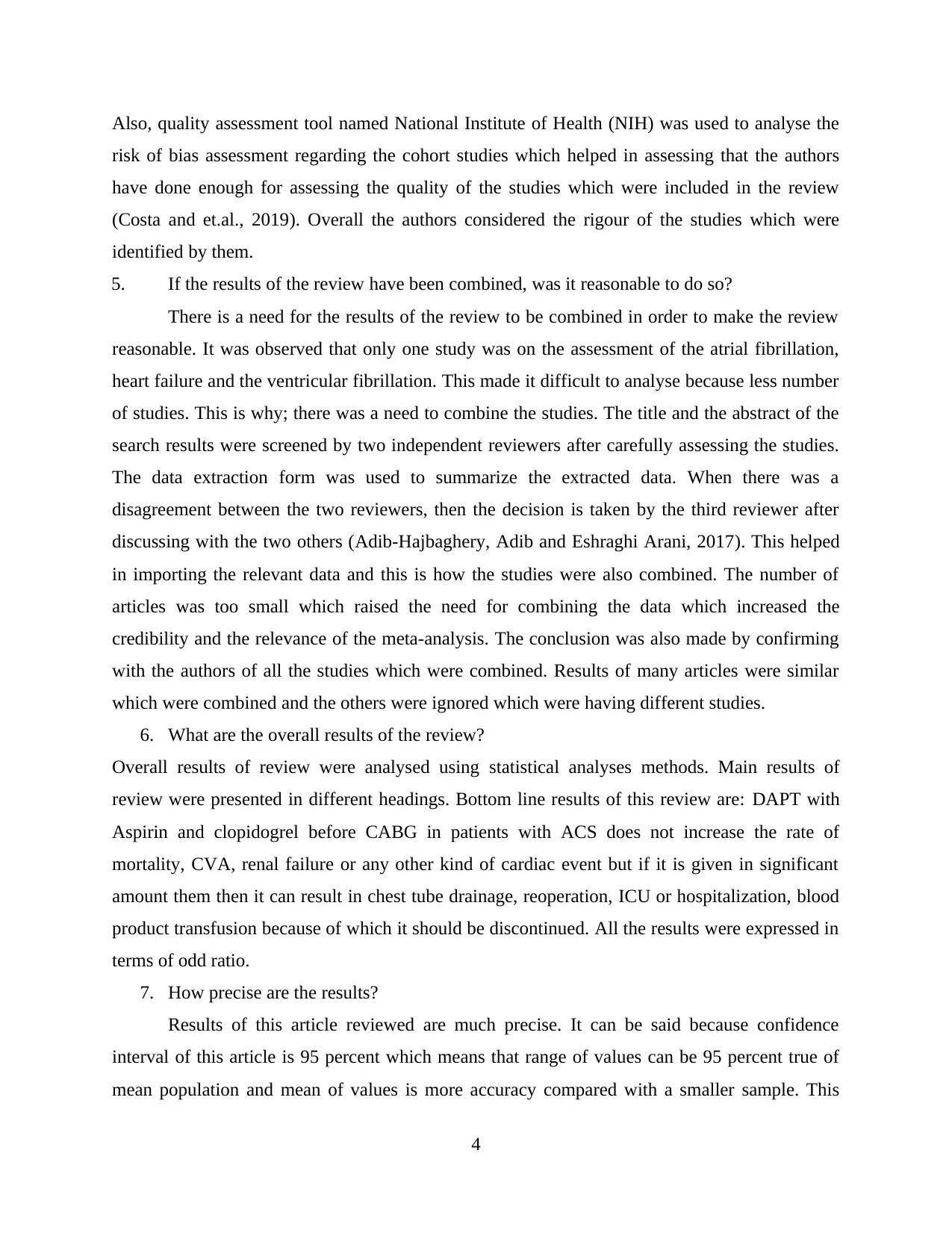
Also, quality assessment tool named National Institute of Health (NIH) was used to analyse the
risk of bias assessment regarding the cohort studies which helped in assessing that the authors
have done enough for assessing the quality of the studies which were included in the review
(Costa and et.al., 2019). Overall the authors considered the rigour of the studies which were
identified by them.
5. If the results of the review have been combined, was it reasonable to do so?
There is a need for the results of the review to be combined in order to make the review
reasonable. It was observed that only one study was on the assessment of the atrial fibrillation,
heart failure and the ventricular fibrillation. This made it difficult to analyse because less number
of studies. This is why; there was a need to combine the studies. The title and the abstract of the
search results were screened by two independent reviewers after carefully assessing the studies.
The data extraction form was used to summarize the extracted data. When there was a
disagreement between the two reviewers, then the decision is taken by the third reviewer after
discussing with the two others (Adib-Hajbaghery, Adib and Eshraghi Arani, 2017). This helped
in importing the relevant data and this is how the studies were also combined. The number of
articles was too small which raised the need for combining the data which increased the
credibility and the relevance of the meta-analysis. The conclusion was also made by confirming
with the authors of all the studies which were combined. Results of many articles were similar
which were combined and the others were ignored which were having different studies.
6. What are the overall results of the review?
Overall results of review were analysed using statistical analyses methods. Main results of
review were presented in different headings. Bottom line results of this review are: DAPT with
Aspirin and clopidogrel before CABG in patients with ACS does not increase the rate of
mortality, CVA, renal failure or any other kind of cardiac event but if it is given in significant
amount them then it can result in chest tube drainage, reoperation, ICU or hospitalization, blood
product transfusion because of which it should be discontinued. All the results were expressed in
terms of odd ratio.
7. How precise are the results?
Results of this article reviewed are much precise. It can be said because confidence
interval of this article is 95 percent which means that range of values can be 95 percent true of
mean population and mean of values is more accuracy compared with a smaller sample. This
4
risk of bias assessment regarding the cohort studies which helped in assessing that the authors
have done enough for assessing the quality of the studies which were included in the review
(Costa and et.al., 2019). Overall the authors considered the rigour of the studies which were
identified by them.
5. If the results of the review have been combined, was it reasonable to do so?
There is a need for the results of the review to be combined in order to make the review
reasonable. It was observed that only one study was on the assessment of the atrial fibrillation,
heart failure and the ventricular fibrillation. This made it difficult to analyse because less number
of studies. This is why; there was a need to combine the studies. The title and the abstract of the
search results were screened by two independent reviewers after carefully assessing the studies.
The data extraction form was used to summarize the extracted data. When there was a
disagreement between the two reviewers, then the decision is taken by the third reviewer after
discussing with the two others (Adib-Hajbaghery, Adib and Eshraghi Arani, 2017). This helped
in importing the relevant data and this is how the studies were also combined. The number of
articles was too small which raised the need for combining the data which increased the
credibility and the relevance of the meta-analysis. The conclusion was also made by confirming
with the authors of all the studies which were combined. Results of many articles were similar
which were combined and the others were ignored which were having different studies.
6. What are the overall results of the review?
Overall results of review were analysed using statistical analyses methods. Main results of
review were presented in different headings. Bottom line results of this review are: DAPT with
Aspirin and clopidogrel before CABG in patients with ACS does not increase the rate of
mortality, CVA, renal failure or any other kind of cardiac event but if it is given in significant
amount them then it can result in chest tube drainage, reoperation, ICU or hospitalization, blood
product transfusion because of which it should be discontinued. All the results were expressed in
terms of odd ratio.
7. How precise are the results?
Results of this article reviewed are much precise. It can be said because confidence
interval of this article is 95 percent which means that range of values can be 95 percent true of
mean population and mean of values is more accuracy compared with a smaller sample. This
4
⊘ This is a preview!⊘
Do you want full access?
Subscribe today to unlock all pages.

Trusted by 1+ million students worldwide
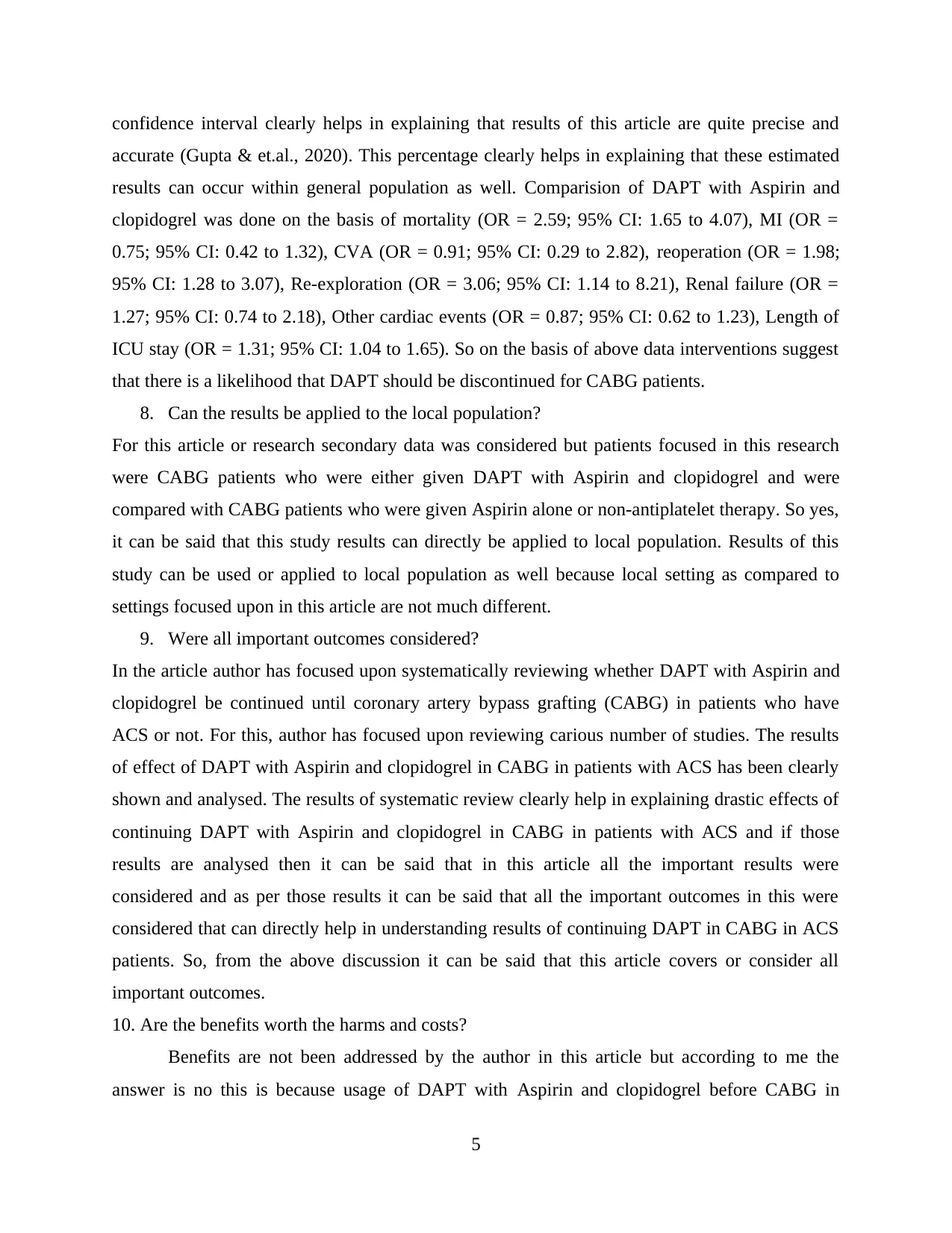
confidence interval clearly helps in explaining that results of this article are quite precise and
accurate (Gupta & et.al., 2020). This percentage clearly helps in explaining that these estimated
results can occur within general population as well. Comparision of DAPT with Aspirin and
clopidogrel was done on the basis of mortality (OR = 2.59; 95% CI: 1.65 to 4.07), MI (OR =
0.75; 95% CI: 0.42 to 1.32), CVA (OR = 0.91; 95% CI: 0.29 to 2.82), reoperation (OR = 1.98;
95% CI: 1.28 to 3.07), Re-exploration (OR = 3.06; 95% CI: 1.14 to 8.21), Renal failure (OR =
1.27; 95% CI: 0.74 to 2.18), Other cardiac events (OR = 0.87; 95% CI: 0.62 to 1.23), Length of
ICU stay (OR = 1.31; 95% CI: 1.04 to 1.65). So on the basis of above data interventions suggest
that there is a likelihood that DAPT should be discontinued for CABG patients.
8. Can the results be applied to the local population?
For this article or research secondary data was considered but patients focused in this research
were CABG patients who were either given DAPT with Aspirin and clopidogrel and were
compared with CABG patients who were given Aspirin alone or non-antiplatelet therapy. So yes,
it can be said that this study results can directly be applied to local population. Results of this
study can be used or applied to local population as well because local setting as compared to
settings focused upon in this article are not much different.
9. Were all important outcomes considered?
In the article author has focused upon systematically reviewing whether DAPT with Aspirin and
clopidogrel be continued until coronary artery bypass grafting (CABG) in patients who have
ACS or not. For this, author has focused upon reviewing carious number of studies. The results
of effect of DAPT with Aspirin and clopidogrel in CABG in patients with ACS has been clearly
shown and analysed. The results of systematic review clearly help in explaining drastic effects of
continuing DAPT with Aspirin and clopidogrel in CABG in patients with ACS and if those
results are analysed then it can be said that in this article all the important results were
considered and as per those results it can be said that all the important outcomes in this were
considered that can directly help in understanding results of continuing DAPT in CABG in ACS
patients. So, from the above discussion it can be said that this article covers or consider all
important outcomes.
10. Are the benefits worth the harms and costs?
Benefits are not been addressed by the author in this article but according to me the
answer is no this is because usage of DAPT with Aspirin and clopidogrel before CABG in
5
accurate (Gupta & et.al., 2020). This percentage clearly helps in explaining that these estimated
results can occur within general population as well. Comparision of DAPT with Aspirin and
clopidogrel was done on the basis of mortality (OR = 2.59; 95% CI: 1.65 to 4.07), MI (OR =
0.75; 95% CI: 0.42 to 1.32), CVA (OR = 0.91; 95% CI: 0.29 to 2.82), reoperation (OR = 1.98;
95% CI: 1.28 to 3.07), Re-exploration (OR = 3.06; 95% CI: 1.14 to 8.21), Renal failure (OR =
1.27; 95% CI: 0.74 to 2.18), Other cardiac events (OR = 0.87; 95% CI: 0.62 to 1.23), Length of
ICU stay (OR = 1.31; 95% CI: 1.04 to 1.65). So on the basis of above data interventions suggest
that there is a likelihood that DAPT should be discontinued for CABG patients.
8. Can the results be applied to the local population?
For this article or research secondary data was considered but patients focused in this research
were CABG patients who were either given DAPT with Aspirin and clopidogrel and were
compared with CABG patients who were given Aspirin alone or non-antiplatelet therapy. So yes,
it can be said that this study results can directly be applied to local population. Results of this
study can be used or applied to local population as well because local setting as compared to
settings focused upon in this article are not much different.
9. Were all important outcomes considered?
In the article author has focused upon systematically reviewing whether DAPT with Aspirin and
clopidogrel be continued until coronary artery bypass grafting (CABG) in patients who have
ACS or not. For this, author has focused upon reviewing carious number of studies. The results
of effect of DAPT with Aspirin and clopidogrel in CABG in patients with ACS has been clearly
shown and analysed. The results of systematic review clearly help in explaining drastic effects of
continuing DAPT with Aspirin and clopidogrel in CABG in patients with ACS and if those
results are analysed then it can be said that in this article all the important results were
considered and as per those results it can be said that all the important outcomes in this were
considered that can directly help in understanding results of continuing DAPT in CABG in ACS
patients. So, from the above discussion it can be said that this article covers or consider all
important outcomes.
10. Are the benefits worth the harms and costs?
Benefits are not been addressed by the author in this article but according to me the
answer is no this is because usage of DAPT with Aspirin and clopidogrel before CABG in
5
Paraphrase This Document
Need a fresh take? Get an instant paraphrase of this document with our AI Paraphraser
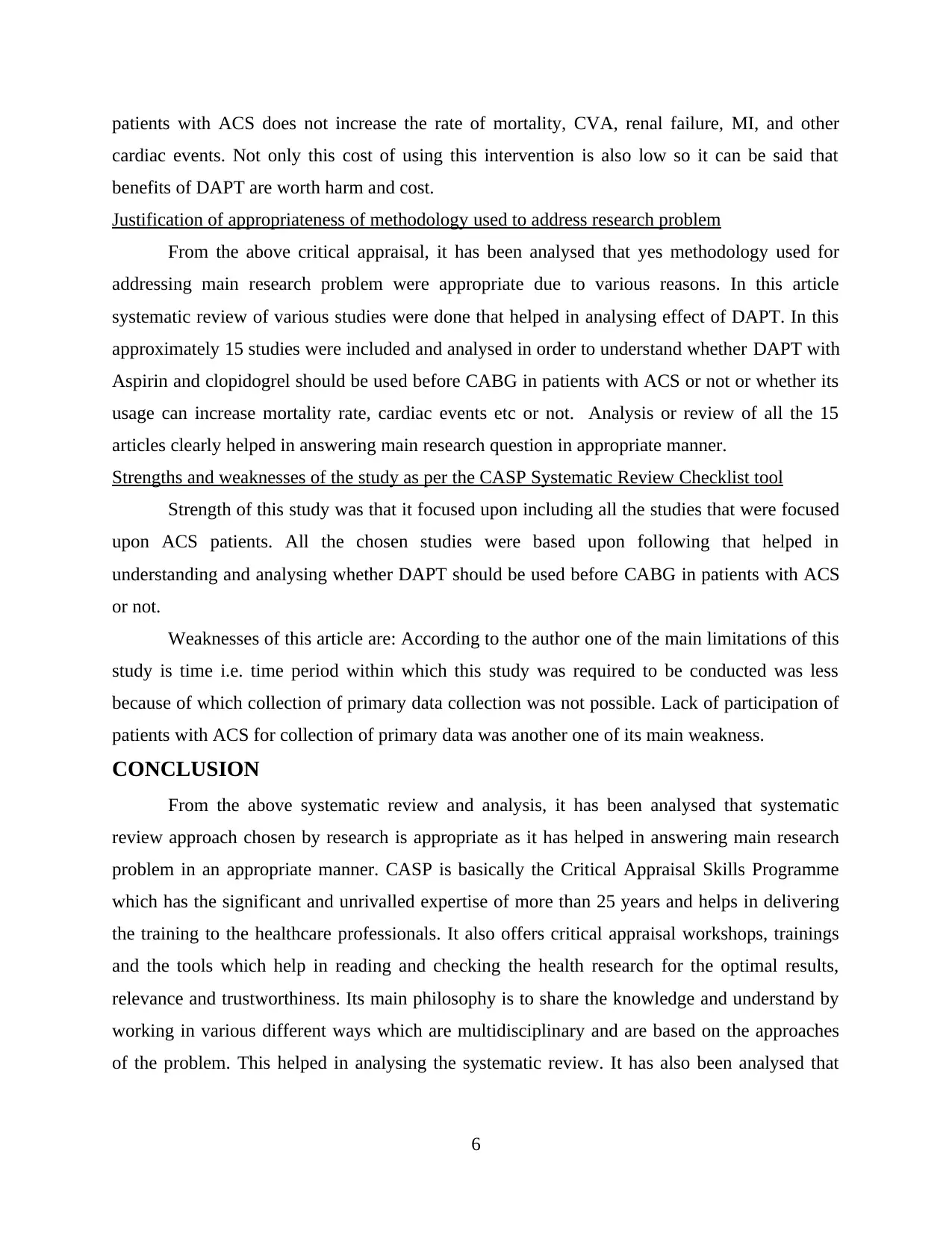
patients with ACS does not increase the rate of mortality, CVA, renal failure, MI, and other
cardiac events. Not only this cost of using this intervention is also low so it can be said that
benefits of DAPT are worth harm and cost.
Justification of appropriateness of methodology used to address research problem
From the above critical appraisal, it has been analysed that yes methodology used for
addressing main research problem were appropriate due to various reasons. In this article
systematic review of various studies were done that helped in analysing effect of DAPT. In this
approximately 15 studies were included and analysed in order to understand whether DAPT with
Aspirin and clopidogrel should be used before CABG in patients with ACS or not or whether its
usage can increase mortality rate, cardiac events etc or not. Analysis or review of all the 15
articles clearly helped in answering main research question in appropriate manner.
Strengths and weaknesses of the study as per the CASP Systematic Review Checklist tool
Strength of this study was that it focused upon including all the studies that were focused
upon ACS patients. All the chosen studies were based upon following that helped in
understanding and analysing whether DAPT should be used before CABG in patients with ACS
or not.
Weaknesses of this article are: According to the author one of the main limitations of this
study is time i.e. time period within which this study was required to be conducted was less
because of which collection of primary data collection was not possible. Lack of participation of
patients with ACS for collection of primary data was another one of its main weakness.
CONCLUSION
From the above systematic review and analysis, it has been analysed that systematic
review approach chosen by research is appropriate as it has helped in answering main research
problem in an appropriate manner. CASP is basically the Critical Appraisal Skills Programme
which has the significant and unrivalled expertise of more than 25 years and helps in delivering
the training to the healthcare professionals. It also offers critical appraisal workshops, trainings
and the tools which help in reading and checking the health research for the optimal results,
relevance and trustworthiness. Its main philosophy is to share the knowledge and understand by
working in various different ways which are multidisciplinary and are based on the approaches
of the problem. This helped in analysing the systematic review. It has also been analysed that
6
cardiac events. Not only this cost of using this intervention is also low so it can be said that
benefits of DAPT are worth harm and cost.
Justification of appropriateness of methodology used to address research problem
From the above critical appraisal, it has been analysed that yes methodology used for
addressing main research problem were appropriate due to various reasons. In this article
systematic review of various studies were done that helped in analysing effect of DAPT. In this
approximately 15 studies were included and analysed in order to understand whether DAPT with
Aspirin and clopidogrel should be used before CABG in patients with ACS or not or whether its
usage can increase mortality rate, cardiac events etc or not. Analysis or review of all the 15
articles clearly helped in answering main research question in appropriate manner.
Strengths and weaknesses of the study as per the CASP Systematic Review Checklist tool
Strength of this study was that it focused upon including all the studies that were focused
upon ACS patients. All the chosen studies were based upon following that helped in
understanding and analysing whether DAPT should be used before CABG in patients with ACS
or not.
Weaknesses of this article are: According to the author one of the main limitations of this
study is time i.e. time period within which this study was required to be conducted was less
because of which collection of primary data collection was not possible. Lack of participation of
patients with ACS for collection of primary data was another one of its main weakness.
CONCLUSION
From the above systematic review and analysis, it has been analysed that systematic
review approach chosen by research is appropriate as it has helped in answering main research
problem in an appropriate manner. CASP is basically the Critical Appraisal Skills Programme
which has the significant and unrivalled expertise of more than 25 years and helps in delivering
the training to the healthcare professionals. It also offers critical appraisal workshops, trainings
and the tools which help in reading and checking the health research for the optimal results,
relevance and trustworthiness. Its main philosophy is to share the knowledge and understand by
working in various different ways which are multidisciplinary and are based on the approaches
of the problem. This helped in analysing the systematic review. It has also been analysed that
6

there are various CASP tools and each of them are used for different research papers for analysis
for appropriateness of methodology or methods used by researcher.
7
for appropriateness of methodology or methods used by researcher.
7
⊘ This is a preview!⊘
Do you want full access?
Subscribe today to unlock all pages.

Trusted by 1+ million students worldwide
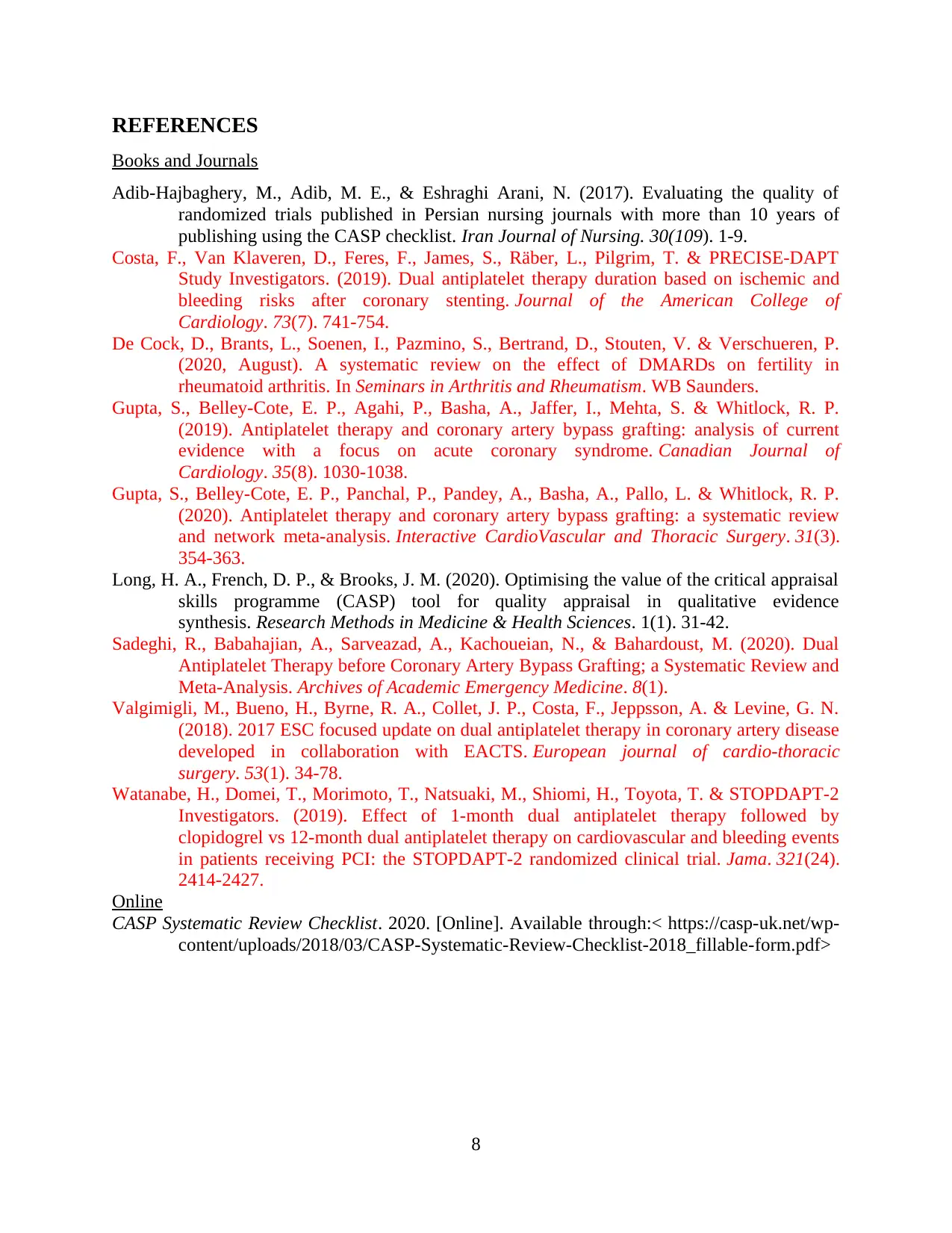
REFERENCES
Books and Journals
Adib-Hajbaghery, M., Adib, M. E., & Eshraghi Arani, N. (2017). Evaluating the quality of
randomized trials published in Persian nursing journals with more than 10 years of
publishing using the CASP checklist. Iran Journal of Nursing. 30(109). 1-9.
Costa, F., Van Klaveren, D., Feres, F., James, S., Räber, L., Pilgrim, T. & PRECISE-DAPT
Study Investigators. (2019). Dual antiplatelet therapy duration based on ischemic and
bleeding risks after coronary stenting. Journal of the American College of
Cardiology. 73(7). 741-754.
De Cock, D., Brants, L., Soenen, I., Pazmino, S., Bertrand, D., Stouten, V. & Verschueren, P.
(2020, August). A systematic review on the effect of DMARDs on fertility in
rheumatoid arthritis. In Seminars in Arthritis and Rheumatism. WB Saunders.
Gupta, S., Belley-Cote, E. P., Agahi, P., Basha, A., Jaffer, I., Mehta, S. & Whitlock, R. P.
(2019). Antiplatelet therapy and coronary artery bypass grafting: analysis of current
evidence with a focus on acute coronary syndrome. Canadian Journal of
Cardiology. 35(8). 1030-1038.
Gupta, S., Belley-Cote, E. P., Panchal, P., Pandey, A., Basha, A., Pallo, L. & Whitlock, R. P.
(2020). Antiplatelet therapy and coronary artery bypass grafting: a systematic review
and network meta-analysis. Interactive CardioVascular and Thoracic Surgery. 31(3).
354-363.
Long, H. A., French, D. P., & Brooks, J. M. (2020). Optimising the value of the critical appraisal
skills programme (CASP) tool for quality appraisal in qualitative evidence
synthesis. Research Methods in Medicine & Health Sciences. 1(1). 31-42.
Sadeghi, R., Babahajian, A., Sarveazad, A., Kachoueian, N., & Bahardoust, M. (2020). Dual
Antiplatelet Therapy before Coronary Artery Bypass Grafting; a Systematic Review and
Meta-Analysis. Archives of Academic Emergency Medicine. 8(1).
Valgimigli, M., Bueno, H., Byrne, R. A., Collet, J. P., Costa, F., Jeppsson, A. & Levine, G. N.
(2018). 2017 ESC focused update on dual antiplatelet therapy in coronary artery disease
developed in collaboration with EACTS. European journal of cardio-thoracic
surgery. 53(1). 34-78.
Watanabe, H., Domei, T., Morimoto, T., Natsuaki, M., Shiomi, H., Toyota, T. & STOPDAPT-2
Investigators. (2019). Effect of 1-month dual antiplatelet therapy followed by
clopidogrel vs 12-month dual antiplatelet therapy on cardiovascular and bleeding events
in patients receiving PCI: the STOPDAPT-2 randomized clinical trial. Jama. 321(24).
2414-2427.
Online
CASP Systematic Review Checklist. 2020. [Online]. Available through:< https://casp-uk.net/wp-
content/uploads/2018/03/CASP-Systematic-Review-Checklist-2018_fillable-form.pdf>
8
Books and Journals
Adib-Hajbaghery, M., Adib, M. E., & Eshraghi Arani, N. (2017). Evaluating the quality of
randomized trials published in Persian nursing journals with more than 10 years of
publishing using the CASP checklist. Iran Journal of Nursing. 30(109). 1-9.
Costa, F., Van Klaveren, D., Feres, F., James, S., Räber, L., Pilgrim, T. & PRECISE-DAPT
Study Investigators. (2019). Dual antiplatelet therapy duration based on ischemic and
bleeding risks after coronary stenting. Journal of the American College of
Cardiology. 73(7). 741-754.
De Cock, D., Brants, L., Soenen, I., Pazmino, S., Bertrand, D., Stouten, V. & Verschueren, P.
(2020, August). A systematic review on the effect of DMARDs on fertility in
rheumatoid arthritis. In Seminars in Arthritis and Rheumatism. WB Saunders.
Gupta, S., Belley-Cote, E. P., Agahi, P., Basha, A., Jaffer, I., Mehta, S. & Whitlock, R. P.
(2019). Antiplatelet therapy and coronary artery bypass grafting: analysis of current
evidence with a focus on acute coronary syndrome. Canadian Journal of
Cardiology. 35(8). 1030-1038.
Gupta, S., Belley-Cote, E. P., Panchal, P., Pandey, A., Basha, A., Pallo, L. & Whitlock, R. P.
(2020). Antiplatelet therapy and coronary artery bypass grafting: a systematic review
and network meta-analysis. Interactive CardioVascular and Thoracic Surgery. 31(3).
354-363.
Long, H. A., French, D. P., & Brooks, J. M. (2020). Optimising the value of the critical appraisal
skills programme (CASP) tool for quality appraisal in qualitative evidence
synthesis. Research Methods in Medicine & Health Sciences. 1(1). 31-42.
Sadeghi, R., Babahajian, A., Sarveazad, A., Kachoueian, N., & Bahardoust, M. (2020). Dual
Antiplatelet Therapy before Coronary Artery Bypass Grafting; a Systematic Review and
Meta-Analysis. Archives of Academic Emergency Medicine. 8(1).
Valgimigli, M., Bueno, H., Byrne, R. A., Collet, J. P., Costa, F., Jeppsson, A. & Levine, G. N.
(2018). 2017 ESC focused update on dual antiplatelet therapy in coronary artery disease
developed in collaboration with EACTS. European journal of cardio-thoracic
surgery. 53(1). 34-78.
Watanabe, H., Domei, T., Morimoto, T., Natsuaki, M., Shiomi, H., Toyota, T. & STOPDAPT-2
Investigators. (2019). Effect of 1-month dual antiplatelet therapy followed by
clopidogrel vs 12-month dual antiplatelet therapy on cardiovascular and bleeding events
in patients receiving PCI: the STOPDAPT-2 randomized clinical trial. Jama. 321(24).
2414-2427.
Online
CASP Systematic Review Checklist. 2020. [Online]. Available through:< https://casp-uk.net/wp-
content/uploads/2018/03/CASP-Systematic-Review-Checklist-2018_fillable-form.pdf>
8
1 out of 10
Related Documents
Your All-in-One AI-Powered Toolkit for Academic Success.
+13062052269
info@desklib.com
Available 24*7 on WhatsApp / Email
![[object Object]](/_next/static/media/star-bottom.7253800d.svg)
Unlock your academic potential
Copyright © 2020–2025 A2Z Services. All Rights Reserved. Developed and managed by ZUCOL.





